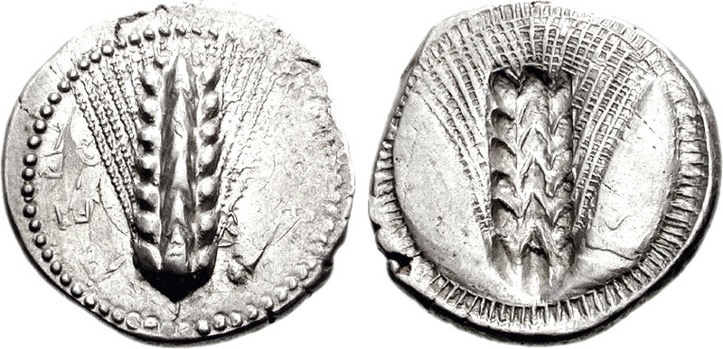1844 - Metapontum (nomos ear of barley/ear of barley) over Syracuse (horseman/Arethusa) (CNG, MBS 72, June 2006, 104)
From SILVER
470 BCE - 440 BCEMETA
Location/history
| Sale(s)Sale(s) ᵖ: | Classical Numismatic Group, MBS 72, 14 June 2006, 104 | |
Overstriking coin
Description
| ObverseInscription or printing placed on the obverse.: | META (Greek) Ear of barley with seven grains. In field, grasshopper. Decorated border. | ReverseInscription or printing placed on the reverse.: | Incuse ear of barley with [six] grains. Border of rays (incuse). |
Mint and issuing power
| MintIdentifies the place of manufacture or issue of a numismatic object.: | Metapontum | Ancient regionAncient region. | Lucania | Modern countryModern country: Italy | AuthorityIdentifies the issuing power. The authority can be "pretended" when the name or the portrait of X is on the coin but he/she was not the issuing power. It can also be "uncertain" when there is no mention of X on the coin but he/she was the issuing power according to the historical sources: |
Chronology
| FromIdentifies the initial date in a range assigned in a numismatic context. 470 BCE toIdentifies the final date in a range assigned in a numismatic context.. 440 BCE | Classical 480-323 BC |
Physical description
| MetalThe physical material (usually metal) from which an object is made.: Silver |
WeightWeight of the numismatic object (in grams). in grams: 8.238.23 g <br />8,230 mg <br /> | DenominationTerm indicating the value of a numismatic object. Examples: tetradrachm, chalkous, denarius.: nomos | AxisDescribes the directional relationship between the obverse and reverse of a numismatic object.: 1212 mm <br />1.2 cm <br /> |
| StandardStandard.: Achaian | |||
References
| Coin referenceReference of the Coin: | Coin series referenceReference to coin series study: | HN Italy1HN Italy, n° 1486, HGC 12HGC 1, n° 1027-1029 | |
| Coin series web referenceCoin series web references: | |||
Overstruck type
Description
| ObverseInscription or printing placed on the obverse.: | Nude rider on horseback right, leading a second horse on far side | ReverseInscription or printing placed on the reverse.: | ΣYPAKOΣION (Greek) Head of Arethusa right within thin linear circle, wearing hair-tie, earring and necklace, hair falling simply behind, ΣVRAQOΣION and four dolphins around |
Mint and issuing power
| MintIdentifies the place of manufacture or issue of a numismatic object. ᵖ: | Syracuse | Ancient regionAncient region. ᵖ | Sicily | Modern countryModern country: Italy | AuthorityIdentifies the authority in whose name (explicitly or implicitly) a numismatic object was issued. ᵖ: |
Chronology
| FromIdentifies the initial date in a range assigned in a numismatic context. 490 BCE toIdentifies the final date in a range assigned in a numismatic context.. 475 BCE | Classical 480-323 BC |
Physical description
| DenominationTerm indicating the value of a numismatic object. Examples: tetradrachm, chalkous, denarius. ᵖ: | didrachm |
StandardStandard. ᵖ: | Attic |
References
| Coin type referenceReference to coin series study ᵖ: | Boehringer 19293Boehringer 1929, p. 121-122, n° 50-53, HGC 24HGC 2, 1351 | ||
| Coin series web reference overstruckCoin series web references overstruck: | |||
Additional data
| Frequency of overstrikesFrequency of overstrikes: | frequent | Level of confidenceLevel of confidence of the identification: | sure |
| RemarksRemarks: | "Overstruck on a didrachm of Syracuse" | ||
References
- ^ Rutter N. Keith et alii (eds.) (2001), Historia Numorum Italy, London, xvi, 223 p., 43 pl.
- ^ Hoover, Oliver D. (2018), The Handbook of Greek Coinage Series, Volume 1. Handbook of Coins of Italy and Magna Graecia, Sixth to First Centuries BC., Lancaster-London, 2018, lxi, 527 pages, 23 cm
- ^ Boehringer, Erich (1929), Die Münzen von Syrakus, Berlin-Leipzig, vi, [2], 297 p. : ill. and portfolio of 32 pl. ; 28 cm
- ^ Hoover, Oliver D. (2012), The Handbook of Greek Coinage Series. 2. Handbook of the Coins of Sicily (Including Lipara). Civic, Royal, Siculo-Punic, and Romano-Sicilian Issues. Sixth to First Centuries BC, Lancaster-London, 489 p.

